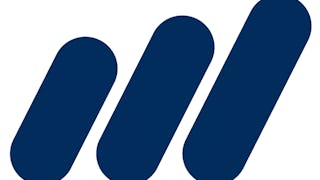This is part of a two-class sequence on financial accounting. FINANCIAL ACCOUNTING I & II, held consecutively, will provide you with a strong foundation to tackle many financial issues. Accounting I covers the basics, while Accounting II deals with more advanced topics. The topics discussed are “general” and apply to accounting practices worldwide – whether in the USA, Europe, Asia, etc. You can take Accounting I on a standalone basis, or, you can take it as part of a two course sequence.



(136 Bewertungen)
Empfohlene Erfahrung
Was Sie lernen werden
Master the mechanics of financial accounting.
Understand the structure, functions, and interrelation of the basic financial statements (balance sheet, income statement, and cash flow statement).
Be able to perform a structured fundamental analysis of the financial statements to assess a firm’s profitability, liquidity, and solvency.
Be familiar with the accounting rules governing the recognition and measurement of key activities, events and transactions.
Wichtige Details

Zu Ihrem LinkedIn-Profil hinzufügen
27 Aufgaben
Erfahren Sie, wie Mitarbeiter führender Unternehmen gefragte Kompetenzen erwerben.


Erwerben Sie ein Karrierezertifikat.
Fügen Sie diese Qualifikation zur Ihrem LinkedIn-Profil oder Ihrem Lebenslauf hinzu.
Teilen Sie es in den sozialen Medien und in Ihrer Leistungsbeurteilung.

In diesem Kurs gibt es 7 Module
Why learn accounting? Because it is an integral part of finance, one of the most sought after and highly paid professions across the world. Financial literacy is extremely valuable from a personal and professional point of view, irrespective of what type of job you are doing.
Das ist alles enthalten
1 Video3 Lektüren
The balance sheet is a THE fundamental financial statement, and learning it is essential when studying accounting. This is a big and complex topic, hence we break it down into two sessions. The learning objectives of this module are: Understand the foundation of double-entry accounting; Understand the accounting equation, Assets = Liabilities + Equity; Understand that every transaction in a company affects at least two accounts and the balance sheet remains balanced; Understand how accountants ensure that financial records are accurate and transactions are properly recorded; Get a snapshot of a company’s financial position; Understanding financial health, by knowing what the company owns (assets), what it owes (liabilities), and what remains to the owners (equity); Understand how to assess liquidity and solvency; Look at current assets (like cash and receivables) and current liabilities, and assess a company’s ability to meet short-term obligations; Understand solvency, by comparing total liabilities to total assets, and evaluate a company's ability to meet long-term debts; Understand how much of a company’s assets are financed by owners, and understand capital structure.
Das ist alles enthalten
1 Video2 Lektüren4 Aufgaben
This is a continuation of Module 1, we go deeper into the details, and we do a lot of practice to solidify our learning. The objectives remain the same as that of Part 1: Understand the foundation of double-entry accounting; Understand the accounting equation, Assets = Liabilities + Equity; Understand that every transaction in a company affects at least two accounts and the balance sheet remains balanced; Understand how accountants ensure that financial records are accurate and transactions are properly recorded; Get a snapshot of a company’s financial position; Understanding financial health, by knowing what the company owns (assets), what it owes (liabilities), and what remains to the owners (equity); Understand how to assess liquidity and solvency; Look at current assets (like cash and receivables) and current liabilities, and assess a company’s ability to meet short-term obligations; Understand solvency, by comparing total liabilities to total assets, and evaluate a company's ability to meet long-term debts; Understand how much of a company’s assets are financed by owners, and understand capital structure.
Das ist alles enthalten
1 Video1 Lektüre5 Aufgaben
The income statement helps us understand performance, which probably is what most people care about the most. This is again a big and complex topic, hence we break it down into two sessions. The learning objectives of this module are: Understand how to measures profitability; Learn to differentiate between revenues vs. expenses vs. profits; Understand bottom line / net income, a key indicator of financial performance; Evaluate the success of the company’s operations; Evaluate operational efficiency, and how a company generates profit from its core operations; Help identify areas where costs can be reduced or revenues can be increased; Understand the components of performance: gross margins, administrative expenses, R&D and marketing, interest expense to bankers, and taxes; Understand how the income statement / company performance affects the balance sheet through equity; Understand the relation between profits and dividends; Understand that concept of accrual accounting: performance and cash flows are not necessarily the same thing.
Das ist alles enthalten
2 Videos2 Lektüren4 Aufgaben
This is a continuation of Module 2, we go deeper into the details, and we do a lot of practice to solidify our learning. The objectives remain the same as that of Part 1: Understand how to measures profitability; Learn to differentiate between revenues vs. expenses vs. profits; Understand bottom line / net income, a key indicator of financial performance; Evaluate the success of the company’s operations; Evaluate operational efficiency, and how a company generates profit from its core operations; Help identify areas where costs can be reduced or revenues can be increased; Understand the components of performance: gross margins, administrative expenses, R&D and marketing, interest expense to bankers, and taxes; Understand how the income statement / company performance affects the balance sheet through equity; Understand the relation between profits and dividends; Understand that concept of accrual accounting: performance and cash flows are not necessarily the same thing.
Das ist alles enthalten
2 Videos1 Lektüre5 Aufgaben
The cash flow statement helps us understand cash movements. Perhaps you know it since you are a child: Cash is King! This is again a big and complex topic, hence we break it down into two sessions. The learning objectives of this module are: Understand how to track movements in cash, inflows and outflows; Understand how much cash is generated and used; Understand how to manage liquidity; Distinguish between different cash activities: operations, investments, financing; Understand the sustainability of the business: are we self-sufficient? Are we liquid? Understand the difference between profitability and cash flows; Understand that accrual accounting used in the income statement has to be complemented by understanding cash positions; Track how much cash goes into investments, whether tangible or intangible; Track what cash is borrowed from banks, and other lenders; Understand how much cash is paid to shareholders in terms of dividends, and how much cash is raised through stock sales; Understand non-cash adjustments, and reconcile between profits and cash movements; Understand how cash flows from the cash flow statement flow into the balance sheet.
Das ist alles enthalten
2 Videos2 Lektüren4 Aufgaben
This is a continuation of Module 3, we go deeper into the details, and we do a lot of practice to solidify our learning. The objectives remain the same as that of Part 1: Understand how to track movements in cash, inflows and outflows; Understand how much cash is generated and used; Understand how to manage liquidity; Distinguish between different cash activities: operations, investments, financing; Understand the sustainability of the business: are we self-sufficient? Are we liquid? Understand the difference between profitability and cash flows; Understand that accrual accounting used in the income statement has to be complemented by understanding cash positions; Track how much cash goes into investments, whether tangible or intangible; Track what cash is borrowed from banks, and other lenders; Understand how much cash is paid to shareholders in terms of dividends, and how much cash is raised through stock sales; Understand non-cash adjustments, and reconcile between profits and cash movements; Understand how cash flows from the cash flow statement flow into the balance sheet.
Das ist alles enthalten
2 Videos1 Lektüre5 Aufgaben
Dozent

Empfohlen, wenn Sie sich für Finance interessieren


University of Lausanne


IESE Business School


Corporate Finance Institute


University of Illinois Urbana-Champaign
Warum entscheiden sich Menschen für Coursera für ihre Karriere?




Bewertungen von Lernenden
136 Bewertungen
- 5 stars
83,82 %
- 4 stars
11,76 %
- 3 stars
2,94 %
- 2 stars
0 %
- 1 star
1,47 %
Zeigt 3 von 136 an
Geprüft am 5. Dez. 2024
The explanations are clear and the practice quizzes are helpful.
Geprüft am 8. Apr. 2025
Sure! Could you clarify what you'd like a review of? It could be a product, service, book, movie, or anything else. Let me know so I can write a thoughtful review for you!
Geprüft am 7. Feb. 2025
Very interesting course, highly recommended. The teacher explains very well and clearly.

Neue Karrieremöglichkeiten mit Coursera Plus
Unbegrenzter Zugang zu 10,000+ Weltklasse-Kursen, praktischen Projekten und berufsqualifizierenden Zertifikatsprogrammen - alles in Ihrem Abonnement enthalten
Bringen Sie Ihre Karriere mit einem Online-Abschluss voran.
Erwerben Sie einen Abschluss von erstklassigen Universitäten – 100 % online
Schließen Sie sich mehr als 3.400 Unternehmen in aller Welt an, die sich für Coursera for Business entschieden haben.
Schulen Sie Ihre Mitarbeiter*innen, um sich in der digitalen Wirtschaft zu behaupten.
Häufig gestellte Fragen
Access to lectures and assignments depends on your type of enrollment. If you take a course in audit mode, you will be able to see most course materials for free. To access graded assignments and to earn a Certificate, you will need to purchase the Certificate experience, during or after your audit. If you don't see the audit option:
The course may not offer an audit option. You can try a Free Trial instead, or apply for Financial Aid.
The course may offer 'Full Course, No Certificate' instead. This option lets you see all course materials, submit required assessments, and get a final grade. This also means that you will not be able to purchase a Certificate experience.
When you purchase a Certificate you get access to all course materials, including graded assignments. Upon completing the course, your electronic Certificate will be added to your Accomplishments page - from there, you can print your Certificate or add it to your LinkedIn profile. If you only want to read and view the course content, you can audit the course for free.
You will be eligible for a full refund until two weeks after your payment date, or (for courses that have just launched) until two weeks after the first session of the course begins, whichever is later. You cannot receive a refund once you’ve earned a Course Certificate, even if you complete the course within the two-week refund period. See our full refund policy.
Weitere Fragen
Finanzielle Unterstützung verfügbar,
 enthalten
enthalten
